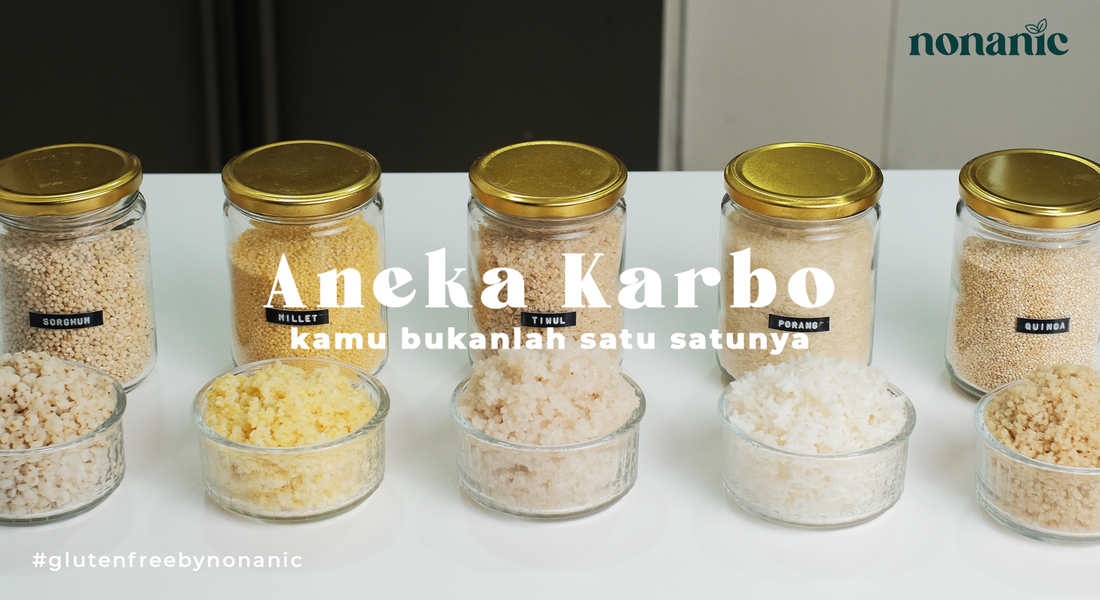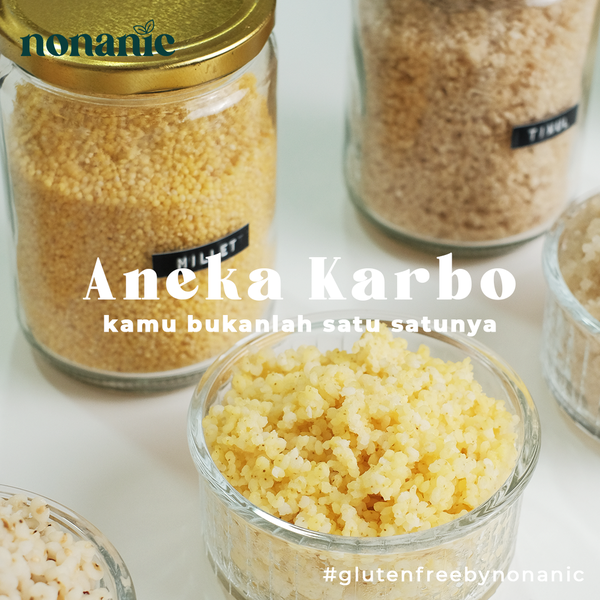
Aneka Karbo

Hi, BestNic! How are you today? I heard you're feeling a bit down, so much so that you don't even feel like eating rice because you haven't gotten a reply from them for three days? Well, you're in luck! Because I'm here to invite you to try some carbs other than rice! Hehehe.
Yup, today we're going to talk about carbohydrates that don't have to come from rice. Honestly, I'm still surprised whenever I hear someone say, "If you haven't eaten rice, then you haven't eaten." Like, hello? We live in a world with tons of other healthy carbohydrate alternatives that are just as good as rice. Especially for us who are living a gluten-free lifestyle, we need something that's truly safe to consume. So, let's explore together!
I'm Cynthia, a baker and gluten-free enthusiast ready to share the secrets of healthy carbs beyond rice. And watch out, there's one that's a crowd favorite but hard to get! Just like that special someone, right? 😜
1. Quinoa: The Beloved Superfood
When it comes to carb alternatives, the first thing that comes to mind is definitely quinoa. It's been a favorite of mine for a long time. Besides being a great source of carbohydrates, quinoa also contains fiber, protein, antioxidants, plus minerals like potassium and magnesium. It's got it all! For those who love experimenting in the kitchen, quinoa is incredibly versatile. You can simply boil it as a rice substitute, or if you're feeling fancy, cook it like risotto. And the best part? Quinoa is gluten-free! So it's super safe for those of us avoiding gluten. Psst, if you haven't tried it yet, make sure to add quinoa to your shopping list this week!
As a source of complex carbohydrates that keep you full longer, quinoa also has tons of health benefits. First, it's rich in fiber, which is great for digestion. Fiber helps keep your digestive system running smoothly and prevents constipation. Quinoa is also high in protein, which is crucial for repairing body cells and building muscles. For vegetarians or vegans, quinoa is an excellent source of complete plant-based protein because it contains all nine essential amino acids that the body needs. Additionally, the antioxidants in quinoa help protect the body from free radicals and prevent premature aging. No wonder quinoa is a favorite for many, including me!
2. Millet: The Multi-Functional Grain
Next up is millet. Heard of it? Millet is a type of grain that's rich in nutrients, fiber, and low in calories. It has a taste similar to broken rice, slightly nutty, and the texture is a bit crunchy. Millet is often used as cereal in India, especially during fasting months, because it provides long-lasting satiety. Not only is it delicious, but millet is also super versatile in cooking.
Millet might be small, but its benefits are huge! This grain is packed with magnesium, which is essential for heart health. Magnesium helps lower blood pressure and reduces the risk of heart disease. Millet is also high in fiber, which can help control blood sugar levels. This is crucial for anyone looking to maintain stable blood sugar or who has diabetes. Plus, millet contains phosphorus, which is good for bone and dental health. For those on a diet, millet is a smart choice because it's low in calories but still fills you up. You can use it as a rice substitute, mix it into salads, or make sweet porridge. Seriously, you have to give it a try!
3. Tiwul: A Proud Local Heritage
Now, let's talk about a truly Indonesian alternative: tiwul. Tiwul is made from cassava flour that's steamed until it fluffs up. For those who don't know, tiwul used to be a staple food in regions where rice was hard to grow, like Central and East Java. There's even a traditional village in Cirendeu, West Java, where people have been eating cassava rice, or tiwul, for hundreds of years. They've stuck with this ancestral food, and honestly, I'm so proud! The taste is unique, slightly sweet, and the texture is a bit chewy, making it feel like you're eating rice but with a different twist. Plus, tiwul is gluten-free and low in calories, so it's perfect for those on a diet or just looking to eat healthily.
As a product of cassava, tiwul is high in fiber, which helps with digestion and keeps the gut healthy. It's also low in calories and gluten-free, so it's safe for those with gluten sensitivities or who are watching their weight. The complex carbohydrates in tiwul help keep your energy levels stable throughout the day. Tiwul is a great choice if you want to eat something filling, healthy, and be proud of our local culinary heritage!
4. Sorghum: The Newcomer That's Gaining Popularity
This one might still be unfamiliar to some of us. It's called sorghum, a type of grain that's starting to be cultivated in Indonesia. Although it's not as popular as the other alternatives yet, sorghum has a lot to offer. Besides being a good source of carbohydrates, sorghum is often processed into gluten-free flour. So, for us who love gluten-free baking or cooking, sorghum can be an exciting ingredient to explore. Its texture is similar to wheat, so it can be used to make bread, pancakes, or even noodles. And even better, by choosing sorghum, we're also supporting our local farmers. Isn't that awesome? 💪
Sorghum isn't just unique; it's also packed with health benefits. One of the most notable is its high fiber content, which is excellent for digestion. The fiber in sorghum also helps reduce bad cholesterol (LDL) in the blood, lowering the risk of heart disease. Additionally, sorghum is rich in iron, which is important for preventing anemia and boosting red blood cell production. Sorghum also contains phenolic compounds that act as antioxidants, helping fight inflammation and protecting the body from various chronic diseases. So, even though sorghum is still new to many, its health benefits are truly amazing! ❤️🔥
5. Porang Rice: The Rice Substitute That’s a Rising Star
Last but not least, we have porang rice. This one might just make you fall in love instantly! It looks just like rice, but with much lower calorie content. But be careful, make sure you choose the right type for your needs, especially if you have allergies to rice or wheat. You can cook it just like regular rice, make porridge, fried rice, or even sushi! Yep, you heard it right. Sushi with porang rice is totally possible and still delicious!
Porang rice is definitely trending right now, and for good reason. One of the main benefits of porang rice is its low-calorie content, which is perfect for those on a diet or looking to maintain their weight. Even though it's low in calories, porang rice is still filling because it contains glucomannan, a type of water-soluble natural fiber. Glucomannan helps control appetite and keeps blood sugar levels stable. Porang rice is also low in carbohydrates, so it's safe for those with diabetes or who are watching their carb intake. Additionally, porang rice contains prebiotics that support the growth of good bacteria in the gut, making your digestion even healthier!
How interesting, right? And don't forget, all these carbs are super safe for those who are gluten intolerant. So, there's no more excuse to struggle to find healthy and gluten-free rice substitutes.
Don't forget to share this article with your fellow gluten-free warriors so they know that living without rice is totally doable! And feel free to comment below if you have any other experiences or tips on cooking with these carb alternatives. Let's share and support each other for a healthier and happier life, even without them—uh, I mean rice. Sorry.
Healthier Rice Alternatives
1. Quinoa
Soak: 2 hours / overnight
Ingredients:
- 170 gr quinoa
- 12 tbsp pandan
- 572 gr water
Instructions:
- Soak quinoa for 2 hours or overnight.
- Add quinoa, pandan, and water in a pot.
- Steam for 30 minutes.
2. Sorghum
Soak: 2 hours / overnight
Ingredients:
- 130 gr sorghum
- 520 gr water
- 1:4 ratio of sorghum to water
- Pandan (optional)
Instructions:
- Soak sorghum for 2 hours or overnight.
- Cook in a rice cooker or stove top with the given water ratio. Adjust the time according to each rice cooker's settings.
- Optionally add pandan for fragrance.
3. Porang Rice
Ingredients:
- 150 gr porang rice
- 180 gr boiling water
Instructions:
- pour the hot water into the porang rice
- close the bowl
- after 1o minutes, the porang rice is ready to use..
4. Millet
Soak: At least 2 hours / overnight
Ingredients:
- 70 gr millet
- 140 gr water (1:2 ratio)
- Pandan (optional)
Instructions:
- Soak millet for at least 2 hours or overnight. then rinse it.
- Cook in a rice cooker or stove top with the given water ratio. Adjust the time according to each rice cooker's settings.
- Optionally add pandan for fragrance.
5. Tiwul (Cassava Rice)
Ingredients:
- 300 gr tiwul
- 380 gr boiling water
Instructions:
- Rinse tiwul well with a flowing water while cleaning the cassava fiber.
- Steam for 15 minutes.
- Optionally add pandan for fragrance.
Tips
Of course, before you start switching to alternative carbs, there are a few important tips you should know to make your healthy diet more effective. Here are three key tips to keep in mind if you want to try carbs other than rice:
1. Pay Attention to Portion Size and Nutrient Combination
For those just starting to explore alternative carbs, it's crucial to keep an eye on portion sizes and nutrient combinations. Even though quinoa, millet, or sorghum are healthy, eating too much of them can still lead to weight gain. Remember, balance is key. Combine these complex carbohydrates with protein sources (like tempeh, tofu, or fish) and fresh vegetables. This way, your body gets complete nutrition and stays energized throughout the day. If you only eat carbs without protein or fiber, you'll feel hungry again more quickly, which can lead to overeating.
2. Vary Your Menu to Avoid Boredom
Sometimes we hesitate to try new foods because they seem complicated or we’re afraid they won’t taste good. But variety is the key to staying motivated on your healthy lifestyle journey. Try different ways to prepare these alternative carbs—for example, quinoa can be made into a salad, millet can be cooked into a sweet porridge, or sorghum can be used for fried rice. By experimenting with different recipes, you can explore various flavors and textures, making it less likely for you to get bored. Plus, this can help you find cooking methods that best suit your taste and your family's preferences.
3. Carefully Check for Gluten Content
This is especially important if you really need to avoid gluten. While most of these alternative carbs are naturally gluten-free, you still need to be cautious about processed products that may be contaminated with gluten. For instance, sorghum and porang rice are gluten-free, but if they’re processed in the same facility as wheat-based products, there's a risk of cross-contamination. That's why it's important to always read labels carefully and make sure the products you buy are certified gluten-free if that matters to you. It's even safer to buy natural ingredients and prepare them yourself at home.
By following these tips, you can enjoy the benefits of alternative carbs with peace of mind and make the most of them. So don’t hesitate to explore healthier and more varied foods that are definitely better for your body. Keep going, BestNic!
Aneka Karbo

Hai, BestNic! Apa kabar hari ini? Denger-denger lagi galau sampe males makan nasi karena chat tiga hari lalu belum dibalas sama si dia ya? Kebetulan dong! Soalnya aku mau ngajakin kamu makan karbo selain nasi! Huehehe
ANEKA KARBO
Yup hari ini kita bakal ngobrolin soal karbohidrat yang ngga harus dari nasi. Jujur aja, aku kadang masih kaget tiap kali denger orang ngomong, "Kalau belum makan nasi, berarti belum makan." Kayak, hello? Kita hidup di dunia yang punya seabrek alternatif karbohidrat lain yang ngga kalah sehatnya dibanding nasi. Apalagi buat kita-kita yang lagi ngejalanin gaya hidup gluten-free, kan butuh yang bener-bener aman buat dikonsumsi. Jadi, yuk kita eksplor bareng-bareng!
Aku Cynthia, seorang baker sekaligus gluten-free enthusiast yang siap ngebagiin rahasia karbo sehat selain nasi. Dan hati-hati ya, ada satu yang jadi favorit sejuta umat, tapi susah didapetin! Kaya si dia gak sih? 😜
1. Quinoa: Si Superfood Kesayangan
Kalau ngomongin alternatif karbo, yang pertama muncul di kepala aku tuh pasti quinoa. Ini tuh udah jadi favorit aku sejak lama. Selain karbohidrat, quinoa juga punya kandungan serat, protein, antioksidan, plus mineral seperti kalium dan magnesium. Pokoknya lengkap deh! Buat yang suka eksperimen di dapur, quinoa ini cocok banget dimasak dengan berbagai cara. Bisa direbus biasa buat jadiin pengganti nasi, atau kalau mau yang lebih fancy, bisa juga dimasak kayak risotto. Terus, serunya lagi, quinoa ini gluten-free! Jadi, aman banget buat kita yang lagi menghindari gluten. Psst, buat yang belum coba, wajib banget masukin quinoa ke dalam list belanjaan minggu ini!
Selain jadi sumber karbohidrat kompleks yang bikin kenyang lebih lama, quinoa juga punya segudang manfaat buat kesehatan. Pertama, quinoa itu kaya serat, jadi bagus banget buat pencernaan. Serat ini membantu melancarkan sistem pencernaan dan mencegah sembelit. Terus, quinoa juga tinggi protein, yang penting banget buat perbaikan sel-sel tubuh dan pembentukan otot. Buat kamu yang vegetarian atau vegan, quinoa ini bisa jadi sumber protein nabati yang lengkap lho, karena mengandung semua sembilan asam amino esensial yang dibutuhkan tubuh. Selain itu, kandungan antioksidan dalam quinoa bantu melindungi tubuh dari radikal bebas dan mencegah penuaan dini. Ngga heran kan kenapa quinoa jadi favorit banyak orang, termasuk aku!
2. Millet: Si Biji-Bijian Multifungsi
Kalau yang satu ini, namanya millet. Udah sering denger belum? Millet ini salah satu jenis biji-bijian yang kaya nutrisi, serat, dan rendah kalori. Rasanya tuh mirip-mirip nasi pecah gitu, agak nutty, dan teksturnya agak renyah. Millet sering banget dipakai jadi sereal di India, apalagi selama bulan puasa, karena bisa ngasih rasa kenyang yang tahan lama. Ngga cuma enak, tapi millet ini juga super fleksibel diolahnya.
Millet mungkin kecil, tapi manfaatnya gede banget! Biji-bijian ini kaya akan magnesium, yang penting banget buat kesehatan jantung. Magnesium bantu menurunkan tekanan darah dan mengurangi risiko penyakit jantung. Terus, millet juga tinggi serat, yang bisa bantu mengontrol gula darah. Ini penting banget buat kamu yang mau menjaga kestabilan gula darah atau yang punya diabetes. Plus, millet mengandung fosfor yang bagus buat kesehatan tulang dan gigi. Buat yang lagi diet, millet bisa jadi pilihan cerdas karena rendah kalori tapi tetap bikin kenyang. Jadi, kamu bisa makan enak tanpa khawatir timbangan naik! Bisa dijadiin pengganti nasi, dicampur ke dalam salad, atau dimasak jadi bubur manis. Serius deh, kamu harus coba!
3. Tiwul: Warisan Lokal yang Bikin Bangga
Sekarang kita ke alternatif yang asli Indonesia banget, yaitu tiwul. Tiwul ini terbuat dari tepung singkong yang dikukus sampai mengembang. Bagi yang belum tau, tiwul ini dulu jadi makanan pokok di daerah-daerah yang sulit menanam padi, seperti di Jawa Tengah dan Jawa Timur. Bahkan, ada kampung adat di Cirendeu, Jawa Barat, yang udah makan nasi singkong alias tiwul ini selama ratusan tahun, lho. Mereka setia sama makanan warisan leluhur ini, dan honestly, I’m so proud! Rasanya sendiri unik, agak manis dan teksturnya sedikit kenyal, bikin kita berasa makan nasi tapi dengan twist yang beda. Plus, tiwul ini gluten-free dan rendah kalori, jadi cocok buat yang lagi diet atau sekedar pengen makan sehat.
Sebagai produk dari singkong, tiwul punya kandungan serat yang tinggi, yang membantu melancarkan pencernaan dan menjaga kesehatan usus. Selain itu, tiwul juga rendah kalori dan bebas gluten, jadi aman banget buat kamu yang punya sensitivitas terhadap gluten atau lagi mengontrol berat badan. Kandungan karbohidrat kompleks dalam tiwul juga bisa bantu menjaga energi tetap stabil sepanjang hari. Tiwul ini pilihan tepat buat kamu yang pengen makan kenyang, sehat, dan pastinya bangga dengan warisan kuliner lokal!
4. Sorghum: Si Pendatang Baru yang Makin Populer
Nah, kalau yang ini mungkin masih terdengar asing buat sebagian dari kita. Namanya sorghum, salah satu jenis biji-bijian yang udah mulai dibudidayakan di Indonesia. Meski belum sepopuler alternatif lainnya, sorghum ini punya banyak keunggulan. Selain jadi sumber karbohidrat yang bagus, sorghum juga sering diolah jadi tepung bebas gluten. Jadi, buat kita yang suka baking atau masak-masak gluten-free, sorghum bisa jadi bahan yang seru buat dieksplor. Teksturnya mirip-mirip sama gandum, jadi bisa dipakai buat bikin roti, pancake, atau bahkan mie. Dan yang lebih penting lagi, dengan memilih sorghum, kita juga dukung petani lokal kita. Bangga banget kan? 💪
Sorghum ngga cuma unik, tapi juga penuh manfaat buat kesehatan. Yang paling menonjol dari sorghum adalah kandungan seratnya yang tinggi, yang bagus banget buat pencernaan. Serat dalam sorghum juga bantu mengurangi kolesterol jahat (LDL) dalam darah, yang bisa menurunkan risiko penyakit jantung. Selain itu, sorghum kaya akan zat besi yang penting buat mencegah anemia dan meningkatkan produksi sel darah merah. Sorghum juga mengandung senyawa fenolik yang bersifat antioksidan, yang membantu melawan peradangan dan melindungi tubuh dari berbagai penyakit kronis. Jadi, walaupun sorghum masih baru dikenal, manfaat kesehatannya sungguh menyala abangkuuu ❤️🔥
5. Beras Porang: Si Pengganti Nasi yang Jadi Primadona
Terakhir, ada yang namanya beras porang. Ini nih yang mungkin bakal bikin kamu langsung jatuh cinta! Bentuknya mirip banget sama nasi, tapi kandungan kalorinya jauh lebih rendah. Tapi, hati-hati ya, pastiin kamu pilih yang sesuai sama kebutuhanmu, terutama kalau kamu alergi sama nasi atau gandum. Tapi tenang aja, beras porang ini fleksibel banget buat diolah. Bisa dimasak langsung kayak nasi biasa, atau dijadiin bubur, nasi goreng, bahkan sushi! Yep, you heard it right. Sushi dengan beras porang itu possible banget dan rasanya tetep enak!
Beras porang ini emang lagi naik daun, dan bukan tanpa alasan. Salah satu manfaat utama beras porang adalah rendahnya kandungan kalorinya, yang cocok banget buat kamu yang lagi diet atau mau menjaga berat badan. Meski kalorinya rendah, beras porang tetap bikin kenyang karena mengandung glucomannan, sejenis serat alami yang larut dalam air. Glucomannan ini bisa membantu mengontrol nafsu makan dan menjaga kestabilan gula darah. Beras porang juga rendah karbohidrat, jadi aman buat yang punya diabetes atau yang lagi mengontrol asupan karbo. Selain itu, beras porang mengandung probiotik yang mendukung pertumbuhan bakteri baik di usus, jadi pencernaan kamu makin sehat deh!
Gimana, menarik banget kan? Dan jangan lupa, semua karbohidrat ini aman banget buat kamu yang gluten intolerant. Jadi, nggak ada alasan lagi buat bingung cari pengganti nasi yang sehat dan gluten-free.
Jangan lupa share artikel ini ke temen-temen pejuang gluten-free lainnya, biar mereka juga tau kalau hidup tanpa nasi tuh sama sekali nggak susah! Kamu juga boleh banget komen di bawah kalau punya pengalaman atau tips lain soal pengolahan karbo alternatif ini. Yuk, kita berbagi dan saling dukung buat hidup yang lebih sehat dan bahagia tentunya, walopun tanpa dia, eh nasi. Maap.
Resep Alternatif Beras yang Lebih Sehat
1. Quinoa
Rendam: 2 jam / semalaman
Bahan:
- 170 gr quinoa
- 12 sdm pandan
- 572 gr air
Instruksi:
- Rendam quinoa selama 2 jam atau semalaman.
- Masukkan quinoa, pandan, dan air ke dalam panci.
- Kukus selama 30 menit dalam air mendidih.
2. Sorghum
Rendam: 2 jam / semalaman
Bahan:
- 130 gr sorgum
- 520 gr air
- Rasio 1:4 antara sorghum dan air
- Pandan (opsional)
Instruksi:
- Rendam sorghum selama 2 jam atau semalaman.
- Masak di rice cooker atau di atas kompor dengan rasio air yang sudah ditentukan. Waktunya sesuaikan dengan rice cooker masing-masing ya 😊
- Tambahkan pandan untuk aroma jika diinginkan.
3. Beras Porang
Bahan:
- 150 gr beras porang
- 180 gr air mendidih
Instruksi:
- Beri air panas mendidih
- Tutup wadah
- Diamkan selama 10 menit.
4. Millet
Rendam: Setidaknya 2 jam / semalaman
Bahan:
- 70 gr millet
- 140 gr air (rasio 1:2)
- Pandan (opsional)
Instruksi:
- Rendam millet selama setidaknya 2 jam atau semalaman. Lalu tiriskan.
- Masak di rice cooker atau di atas kompor dengan rasio air yang sudah ditentukan. Waktunya sesuaikan dengan rice cooker masing-masing ya. 😊
- Tambahkan pandan untuk aroma jika diinginkan.
5. Tiwul
Bahan:
- 300 gr tiwul
- 380 gr air panas
Instruksi:
- Cuci bersih tiwul dengan air mengalir sambil dibersihkan serabut singkong yang menempel
- Kukus dengan air panas selama 15 menit.
- Tambahkan pandan untuk aroma jika diinginkan.
Tips
Tentu aja, sebelum kamu mulai beralih ke karbo alternatif, ada beberapa tips penting yang harus kamu tahu biar diet sehatmu jadi lebih optimal. Nih, aku kasih tiga tips yang harus kamu perhatiin banget kalau mau coba karbo selain nasi:
1. Perhatikan Porsi dan Kombinasi Nutrisi
Buat yang baru mulai eksplor karbo alternatif, penting banget untuk tetap perhatikan porsi makan dan kombinasi nutrisinya. Meski quinoa, millet, atau sorghum sehat, kalau makannya kebanyakan tetap bisa bikin berat badan naik. Ingat, yang terpenting adalah seimbang. Kombinasikan karbohidrat kompleks ini dengan sumber protein (kayak tempe, tahu, atau ikan) dan sayuran segar. Ini supaya tubuh kamu dapat nutrisi lengkap dan tetap bertenaga sepanjang hari. Kalau cuma makan karbo doang tanpa protein atau serat, kamu bakal lebih cepet lapar lagi, dan itu bisa bikin kamu ngemil berlebihan.
2. Variasikan Menu Biar Ngga Bosen
Kadang-kadang kita suka males nyoba makanan baru karena ngerasa ribet atau takut ngga enak. Padahal, variasi itu kunci biar kamu tetap semangat ngejalanin gaya hidup sehat. Coba variasikan cara ngolah karbo alternatif ini, misalnya, quinoa bisa dijadiin salad, millet bisa kamu masak jadi bubur manis, atau sorghum dijadiin nasi goreng. Dengan mencoba berbagai cara olahan, kamu bisa eksplor rasa dan tekstur yang berbeda, jadi ngga gampang bosen. Plus, ini juga bisa bantu kamu temuin cara masak yang paling cocok sama selera kamu dan keluarga.
3. Cek Kandungan Gluten dengan Teliti
Ini yang paling penting buat kamu yang bener-bener harus menghindari gluten. Meski kebanyakan karbo alternatif ini naturally gluten-free, kamu tetap harus hati-hati sama produk olahan yang mungkin terkontaminasi gluten. Misalnya, sorghum dan beras porang memang bebas gluten, tapi kalau diolah di tempat yang sama dengan produk berbasis gandum, ada risiko kontaminasi silang. Makanya, selalu baca label dengan teliti dan pastikan produk yang kamu beli punya sertifikasi bebas gluten kalau itu penting buat kamu. Lebih aman lagi, kalau bisa, beli bahan-bahan yang alami dan olah sendiri di rumah.
Dengan mengikuti tips-tips ini, kamu bisa menikmati manfaat karbo alternatif dengan tenang dan maksimal. Jadi, jangan ragu buat eksplor makanan sehat yang lebih bervariasi dan pastinya lebih ramah buat tubuhmu. Semangat terus ya, bestNic!





